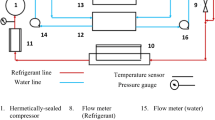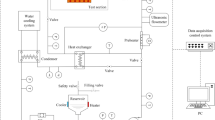Abstract
Future space equipment and applications would require a high amount of heat dissipation. In such applications, minichannel, as an integral component of the compact cooling device, could play a significant role in maintaining the electronics temperature within a tolerable limit and reducing the spacecraft weight. The present study deals with condensation heat transfer in a two-dimensional minichannel with R134a as a working fluid. A novel numerical model capable of analysing the condensation of vapour in minichannel owing to the temperature difference and the change in local vapour pressure resulting from the flow passage contraction due to the developed liquid layer is proposed and validated with the existing literature. The Volume of Fluid (VOF) approach is used for two-phase interface tracking. The effects on the performance of the minichannel condensation process, thin liquid film layer development, and prediction of two-phase (liquid–vapour) interface profile due to variations in inlet vapour mass flux and minichannel diameter are investigated. The gravity effect is studied by considering five different conditions of 0, 0.5, 1, 5 and 9.81 m/s2. Additionally, three different inlet mass fluxes of 250 kg/m2.s, 500 kg/m2.s and 750 kg/m2.s are considered. For each mass flux, three different channel diameters are considered, viz. 1 mm, 2 mm and 3 mm at g = 0 and 9.81 m/s2. Outcomes of the study show that the average Nusselt number increases as inlet vapour mass flux increases. The increment in inlet vapour mass flux causes significantly delayed fluctuations in the flow. It is observed that as the minichannel diameter increases, the average heat transfer coefficient reduces significantly.





















Similar content being viewed by others
Availability of data and material
The data that support the findings of this study are available from the corresponding author upon reasonable request.
Abbreviations
- c p :
-
Specific heat capacity, J/kg.K
- D :
-
Channel diameter, m
- g:
-
Gravitational acceleration, m/s2
- G in :
-
Inlet mass flux, kg/m2.s
- h :
-
Specific enthalpy, kJ/kg
- h avg :
-
Average heat transfer coefficient, W/m2.K
- k :
-
Thermal conductivity, W m−1 K−1
- L :
-
Channel length, m
- \({\dot{m}}_{s}\) :
-
Rate of mass transfer
- Nu avg :
-
Average Nusselt number
- Nu loc :
-
Local Nusselt number
- \({q''}\) :
-
Heat flux, W/m2
- Q L :
-
Latent heat, kJ/kg
- r c :
-
Curvature of the interface, m
- \({S}_{E}\) :
-
Source term in the energy equation, W/m3
- \({\overrightarrow{S}}_{m}\) :
-
Source term in the momentum equation, W/m3
- x :
-
Local channel length from the inlet, mm
- T :
-
Temperature, K
- ΔT :
-
Tsat—Twall, K
- ΔT ´ :
-
Tliq—Twall, K
- t ∞ :
-
Mean flow time scale
- U ∞ :
-
Inlet velocity, m/s
- ρ :
-
Density, kg/m3
- μ :
-
Dynamic viscosity, Pa.s
- ν :
-
Kinematic viscosity, m2/s
- σ :
-
Surface tension, N/m
- ϕ :
-
Void fraction
- α :
-
Volume fraction
- cu :
-
Copper
- eff :
-
Effective
- in :
-
Inlet
- p :
-
Pressure
- L :
-
Latent heat
- loc :
-
Local
- avg :
-
Average
- l :
-
Liquid
- v :
-
Vapour
- sat :
-
Saturation
- K :
-
Kunz's mass transfer model
- x :
-
Location along the channel
- w :
-
Wall
- Model -A:
-
‘pressTempCondensatingEvaporatingFoam’ solver
- Model -B:
-
‘interCondensatingEvaporatingFoam’ solver
References
Chen Y, Shi M, Cheng P, Peterson G (2008) Condensation in microchannels. Nanosc Microsc Thermophys Eng 12:117–143
Cavallini A, Doretti L, Matkovic M, Rossetto L (2006) Update on condensation heat transfer and pressure drop in minichannels. Heat Transfer Eng 27:74–87
Nebuloni S, Thome JR (2010) Numerical modeling of laminar annular film condensation for different channel shapes. Int J Heat Mass Transfer 53:2615–2627
Ding Y, Jia L (2017) Study on flow condensation characteristics of refrigerant R410a in a single rectangular micro-channel. Int J Heat Mass Transf 114:125–134
Bortolin S, Da Riva E, Del Col D (2014) Condensation in a square minichannel: application of the VOF method. Heat Transfer Eng 35(2):193–203
Lyulin Y, Marchuk I, Chikov S, Kabov O (2011) Experimental study of laminar convective condensation of vapour inside an inclined circular tube. Sci Technol 23:439–445
Lips S, Meyer JP (2012) Experimental study of convective condensation in an inclined smooth tube. Part 1: Inclination effect on flow pattern and heat transfer coefficient. Int J Heat Mass Transfer 53:395–404
Wang BX, Du XZ (2000) study on laminar film-wise condensation for vapor flow in an inclined small/mini-diameter tube. Int J Heat Mass Transf 43:1859–1868
Da Riva E, Del Col D (2012) Numerical simulation of laminar liquid film condensation in a horizontal circular minichannel. ASME J Heat Transfer 134:051019-1–51028
Cavallini A, Del Col D, Doretti L, Matkovic M, Rossetto L, Zilio C (2005) Condensation heat transfer and pressure gradient inside multiport minichannels. Heat Transfer Eng 26(3):45–55
Ganapathy H, Shooshtari A, Choo K, Dessiatoun S, Alshehhi M, Ohadi M (2013) Volume of fluid-based numerical modeling of condensation heat transfer and fluid flow characteristics in microchannels. Int J Heat Mass Transf 65:62–72
Lee J, O'Neill LE, Mudawar I (2020) 3-D computational investigation and experimental validation of effect of shear-lift on two-phase flow and heat transfer characteristics of highly subcooled flow boiling in vertical upflow. Int J Heat Mass Transfer 150:119291
Li W, Zhang J, Mi P, Zhao J, Tao Z, Childs PRN, Shih TI-P (2017) The effect of gravity on R410a condensing flow in horizontal circular tubes. Numer Heat Transfer, Part A 71(3):327–340
Da Riva E, Del Col D (2011) Effect of gravity during condensation of R134a in a circular minichannel. Microgravity Sci Technol 23:87–97
Zhao TS, Liao Q (2002) Theoretical analysis of film condensation heat transfer inside vertical mini triangular channels. Int J Heat Mass Transf 45:2829–2842
Lee H, Kharangate CR, Mascarenhas N, Park I, Mudawar I (2015) Experimental and computational investigation of vertical downflow condensation. Int J Heat Mass Transf 85:865–879
Gu X, Wen J, Tian J, Li C, Liu H, Wang S (2019) role of gravity in condensation flow of R1234ze(E) inside horizontal mini/macro-channels. Experimental Comput Multiph Flow 1(3):219–229
Ganapathy H, Al-Hajri E, Ohadi MM (2013) Phase field modeling of Taylor flow in mini/micro channels. Part I: Bubble formation mechanisms and phase field parameters. Chem Eng Sci 94:138–149
O’Neill LE, Balasubramaniam R, Nahra HK, Hasan MM, Mudawar I (2019) Flow condensation heat transfer in a smooth tube at different orientations: Experimental results and predictive models. Int J Heat Mass Transf 140:533–563
Greenshields CJ (2017) OpenFOAM user guide, OpenFOAM Foundation Ltd, version 8. https://cfd.direct/openfoam/user-guide/ (last accessed on 11 August 2020)
Rusche H (2002) Computational fluid dynamics of dispersed two-phase flows at high phase fractions, in, University of London
Brackbill JU, Kothe DB, Zemach C (1992) A continuum method for modeling surface tension. J Comput Phys 100:335–354
Dong Z, Xu J, Jiang F, Liu P (2012) Numerical study of vapor bubble effect on flow and heat transfer in microchannel. Int J Therm Sci 54:22–32
Russo E, Kuerten JGM, van der Geld CWM, Geurts BJ (2014) Water droplet condensation and evaporation in turbulent channel flow. J Fluid Mech 749:666–700
Kunz RF, Boger DA, Stinebring DR, Chyczewski TS, Lindau JW, Gibeling HJ, Venkateswaran S, Govindan TR (2000) A preconditioned Navier-Stokes method for two-phase flows with application to cavitation prediction. Comput Fluids 29(8):849–875
ASHRAE Handbook–Fundamentals (SI Edition) (2009)
Sangtabi AR, Kianifar A, Alizadeh E (2020) Effect of water vapor condensation on the flow distribution in a PEM fuel cell stack. Int J Heat Mass Transfer 151:119471
Jithesh PK, Bansode AS, Sundararajan T, Das SK (2012) The effect of flow distributors on the liquid water distribution and performance of a PEM fuel cell. Int J Hydrogen Energy 37:17158–17171
Ewim DRE, Meyer JP, Noori Rahim Abadi SMA (2018) Condensation heat transfer coefficients in an inclined smooth tube at low mass fluxes. Int J Heat Mass Transfer 123:455–467
Yan YY, Lin TF (1999) Condensation heat transfer and pressure drop of refrigerant R1023a in a small pipe. Int J Heat Mass Transf 42:697–708
Wang Y, Sefiane K, Wang Z, Harmand S (2014) Analysis of two-phase pressure drop fluctuations during micro-channel flow boiling. Int J Heat Mass Transf 70:353–362
Wen J, Gu X, Liu Y, Wang S, Li Y (2018) Effect of surface tension, gravity and turbulence on condensation patterns of R1234ze (E) in horizontal mini/macro-channels. Int J Heat Mass Transf 125:153–170
Acknowledgements
The authors acknowledge the financial support from the Indian Space Research Organisation- ISRO-IIT (B) SPACE TECHNOLOGY CELL through grant number: RD/0119-ISROC00-014.
Author information
Authors and Affiliations
Corresponding author
Ethics declarations
Conflicts of interest
On behalf of all authors, the corresponding author states that there is no conflict of interest.
Additional information
Publisher's Note
Springer Nature remains neutral with regard to jurisdictional claims in published maps and institutional affiliations.
Rights and permissions
About this article
Cite this article
Pramanick, S., Dey, P. & Saha, S.K. Development of numerical model to study the effect of condensate liquid layer on condensation heat transfer of R134a in minichannel. Heat Mass Transfer 58, 2029–2046 (2022). https://doi.org/10.1007/s00231-022-03213-2
Received:
Accepted:
Published:
Issue Date:
DOI: https://doi.org/10.1007/s00231-022-03213-2




